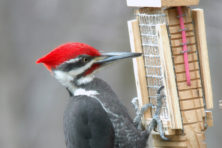How to Garden for the Birds
- Share
- Tweet
- Pin
- Share

Like a well-thrown knuckleball, it was slow-moving and erratic. Smaller than a baseball but bigger than a bumblebee. A little grey fuzzy-looking sphere was fluttering along toward me. It collided with my chest and fell right into my hand, then looked around as with a sense of accomplishment.
It was probably this fledgling’s first flight. I mentioned to the “chickadee-chick” that it should be glad I’m not a cat. After a moment, it took to the air again and returned to the vicinity of its nest near the back of our backyard.
That little bird didn’t just show up at random. The crucial concept is habitat, which can be thought of as a critter’s address, consisting of sufficient food, water, cover, nesting opportunities and elbow room. Without all of these ecological attributes there would be no chickadees. In fact, truth be told, loss of habitats across America is responsible for declines in countless populations of flora and fauna. Unless we all do our part to restore native vegetation in our own landscapes, we stand to lose most of the species that graced this amazing place prior to Columbus.
We have to take on some responsibility. It begins in our own yards. At our previous home, we had enhanced our landscape with dozens of native shrubs and trees, along with numerous herbaceous plants. As the landscape matured, it became much more than just another yard. It blossomed into a bird sanctuary, and the chickadees responded.
Native oaks and cherry, along with shrubs, such as dogwood, hazelnut, ninebark, and viburnum, can offer food and cover, hosting many species of butterflies and moths. These can make a terrific start; then consult with various landscapers and insist on native plants. Non-natives provide almost no sustenance for the insect larvae so crucial to bird nesting success. Proper plants are fundamental.
Nestlings require a lot of food. The food consists of butterfly and moth larvae, various other insects and spiders. A typical chickadee nest could host half a dozen hungry mouths. Working together, the parents can easily make more than 500 feeding forays a day, amounting to some 9,000 lunches, just to get off the nest. And they only forage in about a 50 meter radius.
Fast forward to our new home in Algoma. Before we replaced expansive lawn with various (mostly native) plants, hordes of spiders had found our house a safe haven from which to snare insects. We still have spiders, but not in hordes. Our spiders now sustain a wide variety of birds, and various other critters in our living landscape. These in turn discourage any one species from becoming a “pest.”
There are a few don’ts to balance out the many do’s in managing a healthy personal landscape.
Don’t allow those cute cuddly cats to become fearsome feral bird murderers. This has become a serious problem. Each year, by some estimates, cats kill more than three billion birds just in America. We need effective leash laws. It’s in the cat’s best interest. On average, house cats outlive their outdoor counterparts by a factor of about four times.
Don’t spray or hire someone to spray for weeds, insects, or spiders. Poisons are designed to kill and are problematic; they don’t know when to quit. The poisoned spider or bug, when fed to a chickadee or hummingbird nestlings, can do them in. The toxic weed killer on lawns can get tracked into the home or washed down the watershed, dispersing its carcinogenic and endocrine-disruptive tendencies.
As Rachel Carson intimated, diversity is the best antidote to pest outbreaks.



